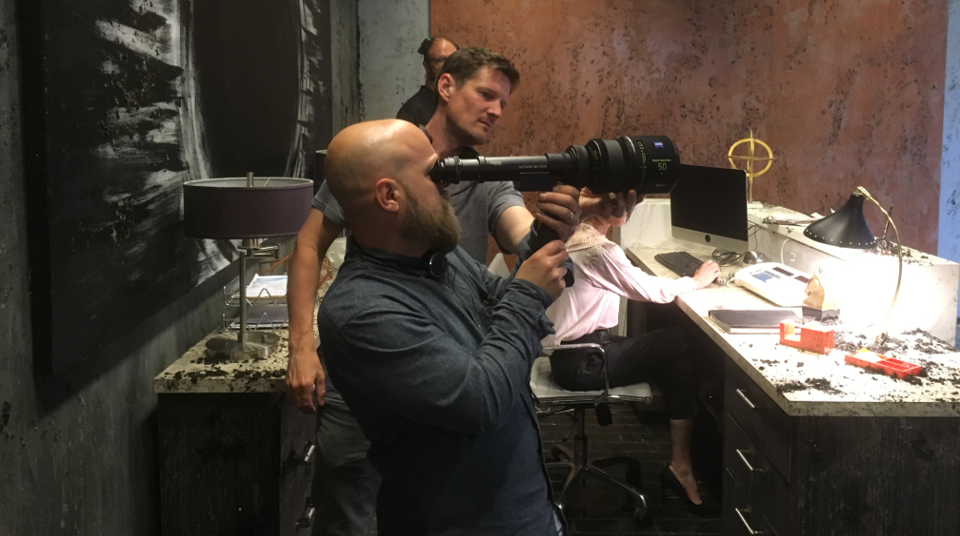
[This is the second in a series of posts on the shooting of the “This Way to Egress” segment of Nightmare Cinema. You can find the first installment here. The film is available for free on Freevee and Tubi or to rent or own on Amazon, Apple, and Vudu.]
Filming “This Way to Egress” began six years ago this month in an office building in downtown LA.
Choosing a practical set was important to Director David Slade, for although the story takes place in a world that is rapidly sinking into a surrealistic nightmare, he wanted to maintain a sense of the real. “I wanted to use a real location,” he told Shannon Mcgrew at the blogsite Nightmarish Conjurings. “I didn’t want to build a set for it, I just wanted a sense of realism.”
As I recall, David had at one point considered filming in LA’s Bradbury Building, which might have worked well, given its ornate ironwork, flying staircases, and open-cage elevators. But as a film set, that location had already been used to good effect in Ridley Scott’s Blade Runner and the well-regarded Outer Limits episode “Demon with the Glass Hand.”
Less familiar to film audiences, another building a few blocks away proved a better choice. Among its visually interesting details is the 10-foot tall door in the reception area where Helen waits to meet with Dr. Salvador. Featured in Egress’s opening scene, the portal forms a dividing line between Helen (Elizabeth Reaser) and her boys Eric (Lucas Barker) and Chris (Macintyre Sweeney) as they sit on opposite ends of a windowless, high-ceilinged space.

The room conveys a sense of stark tension, with the closed door splitting the composition into mirrored halves, each with a curved sofa, lamp, and end table. Between them, a white tabletop lies strewn with what at first look to be ordinary magazines. GQ, Vogue, Vanity Fair–titles you might expect to find in a waiting room.
But then things begin to change.
After leaving her boys to check with the receptionist (Browyn Mo), Helen returns to find the space dusted with grit and ash, and then–a little later, upon leaving her sessions with Dr. Salvador (Adam Godley)–she finds the room completely transformed beneath smears of black grit (or is it clotted blood?).
To create the effect, Production Designer Lauren Fitzsimmons and her crew applied what looked to be a mixture of blackened oatmeal and sawdust to the walls, floor, furniture, and even the clothes and faces of the people Helen encounters during her descent.

The effects were then digitally enhanced in post by Kevin Tod Haug of Trimaran VFX, who added additional layers that permiate the air to swirl around Helen and her children in the story’s climax.
Interestingly, the practical grit and slime were all applied before shooting began, which allowed the waiting-room scenes to be filmed in reverse order. Thus, scenes taking place during the depths of Helen’s descent were filmed first, after which the crew gradually stripped away the layers to arrive at the spotless first scene, making the film’s opening tableau the final scene shot on that location.

When production on the waiting-room set wrapped late in the evening on June 16, the crew had considerably less cleanup to do than they would have if the scenes had been filmed in chronological order.
The following day, production moved to its second location. I’ll get to what happened there in an upcoming post, but first we’ll take a closer look at some of the other effects used to create the nightmare world of “This Way to Egress.” In particular, I’d like to share some of the extensive preparations that went into creating a starling moment at the film’s climax.
Look for that in my next post.
In the meantime, here’s a demo reel from Trimaran VFX that shows how digital effects took the production’s practical grit, slime, and flying ash to a new and terrifying level.
VFX Film “Nightmare Cinema” – David Slade – Indy Entertainment (Los Angeles – USA) from Trimaran VFX on Vimeo.

Leave a Reply